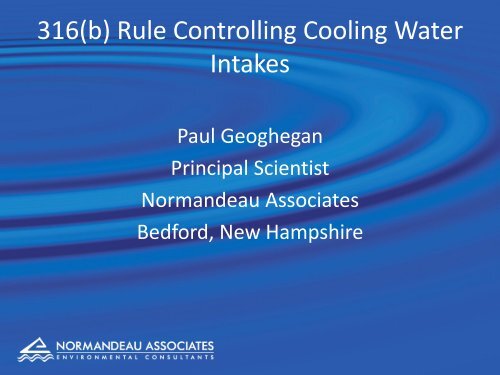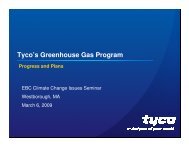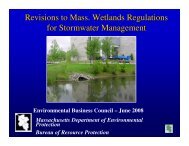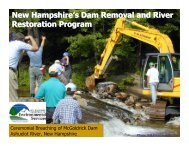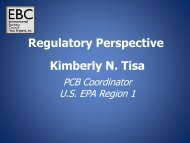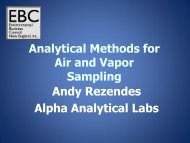316(b) Rule Controlling Cooling Water Intakes
316(b) Rule Controlling Cooling Water Intakes
316(b) Rule Controlling Cooling Water Intakes
You also want an ePaper? Increase the reach of your titles
YUMPU automatically turns print PDFs into web optimized ePapers that Google loves.
<strong>316</strong>(b) <strong>Rule</strong> <strong>Controlling</strong> <strong>Cooling</strong> <strong>Water</strong><br />
<strong>Intakes</strong><br />
Paul Geoghegan<br />
Principal Scientist<br />
Normandeau Associates<br />
Bedford, New Hampshire
Section <strong>316</strong>(b) of the CWA<br />
…the location, design, construction, and<br />
capacity of cooling water intake structures<br />
reflect the best technology available for<br />
minimizing adverse environmental impact...
<strong>316</strong>(b) <strong>Rule</strong><br />
• US power plants withdraw 201 BGD for<br />
cooling water<br />
• <strong>Rule</strong>making Effort under Section <strong>316</strong>(b) of the<br />
CWA ongoing since 1976<br />
• 2004 rule published but later withdrawn<br />
• New Draft rule in comment period
Typical <strong>Cooling</strong> <strong>Water</strong> Intake Screen
Impingement and Entrainment<br />
IMPINGEMENT<br />
ENTRAINMENT<br />
Adult and<br />
juvenile fish<br />
are impinged on<br />
the screen<br />
Fish in fish return trough<br />
Small juveniles, fish larvae<br />
and eggs pass through<br />
screens, through the CWS<br />
and return to ambient water.
POWER PLANT IMPACT<br />
ORIGINAL<br />
High<br />
IMPACT<br />
Thermal<br />
ACTUAL<br />
Low<br />
Impingement<br />
Low<br />
Entrainment<br />
High
Who does this rule apply to<br />
• Withdraw > 2 MGD and use 25% or more for<br />
cooling<br />
• Intake through-screen velocity ≤ 0.5 ft/sec<br />
– 15% blockage<br />
• Most power plants
Performance Standards<br />
• Impingement<br />
– Used Ristroph screen fish return system as BTA<br />
– Monthly mortality: 31%<br />
– Annual mortality: 12%<br />
• Entrainment<br />
– No BTA declared<br />
– Case by case determination<br />
– States to use BPJ based on 9 factors including<br />
social cost and benefit 125.98(e)
Design Flow of 50 MGD or more<br />
• Source water physical data 122.21(r)(2)<br />
• CWIS data 122.21(r)(3)<br />
• Source water biological characterization<br />
122.21(r)(4)<br />
• <strong>Cooling</strong> water system data 122.21(r)(5)<br />
• Impingement mortality reduction plan<br />
122.21(r)(6)<br />
• Performance studies 122.21(r)(7)<br />
• Operational status 122.21(r)(8)
Actual Flow of 125 MGD or more<br />
• All of the above plus:<br />
• Entrainment characterization study 122.21(r)(9)<br />
• Feasibility and cost evaluation study 122.21(r)(10)<br />
• Benefits valuation study 122.21(r)(11)<br />
• Non water-quality and other environmental<br />
impact study 122.21(r)(12)
Weaknesses<br />
• Doesn’t account for site specific costs for<br />
impingement<br />
– Offshore intakes<br />
• Doesn’t account for steps already taken<br />
– Ignores results of mandated monitoring programs<br />
• Impingement mortality of shellfish<br />
– Comparable to that achieved by barrier net<br />
– What’s a shellfish<br />
– Even for a few shellfish


